Management Accounting and Business Strategies: Divine Denim Report
VerifiedAdded on 2022/09/26
|18
|2330
|23
Report
AI Summary
This report provides a comprehensive analysis of Divine Denim, a growing company specializing in designer denim jeans and jackets. The report begins with a business background, outlining the company's operations and expansion into Ready-to-Wear (RTW) clothing. It then applies Porter's Five Forces framework to assess the competitive environment, evaluating the threat of new entrants, bargaining power of buyers and suppliers, threat of competitors, and the threat of substitutes. The analysis highlights the impact of these forces on Divine Denim's business and examines how the company can use cost leadership, differentiation, and focus strategies to gain a competitive advantage. The report continues with a detailed examination of direct and indirect costs, allocation methods, process costing using FIFO and weighted average methods, and a cash budget. The cash budget includes inflows, outflows, and financing requirements, along with a schedule of sales and production budgets. Finally, the report connects the cost leadership strategy to the company's budgeting process, showing how it helps control expenses and increase sales.
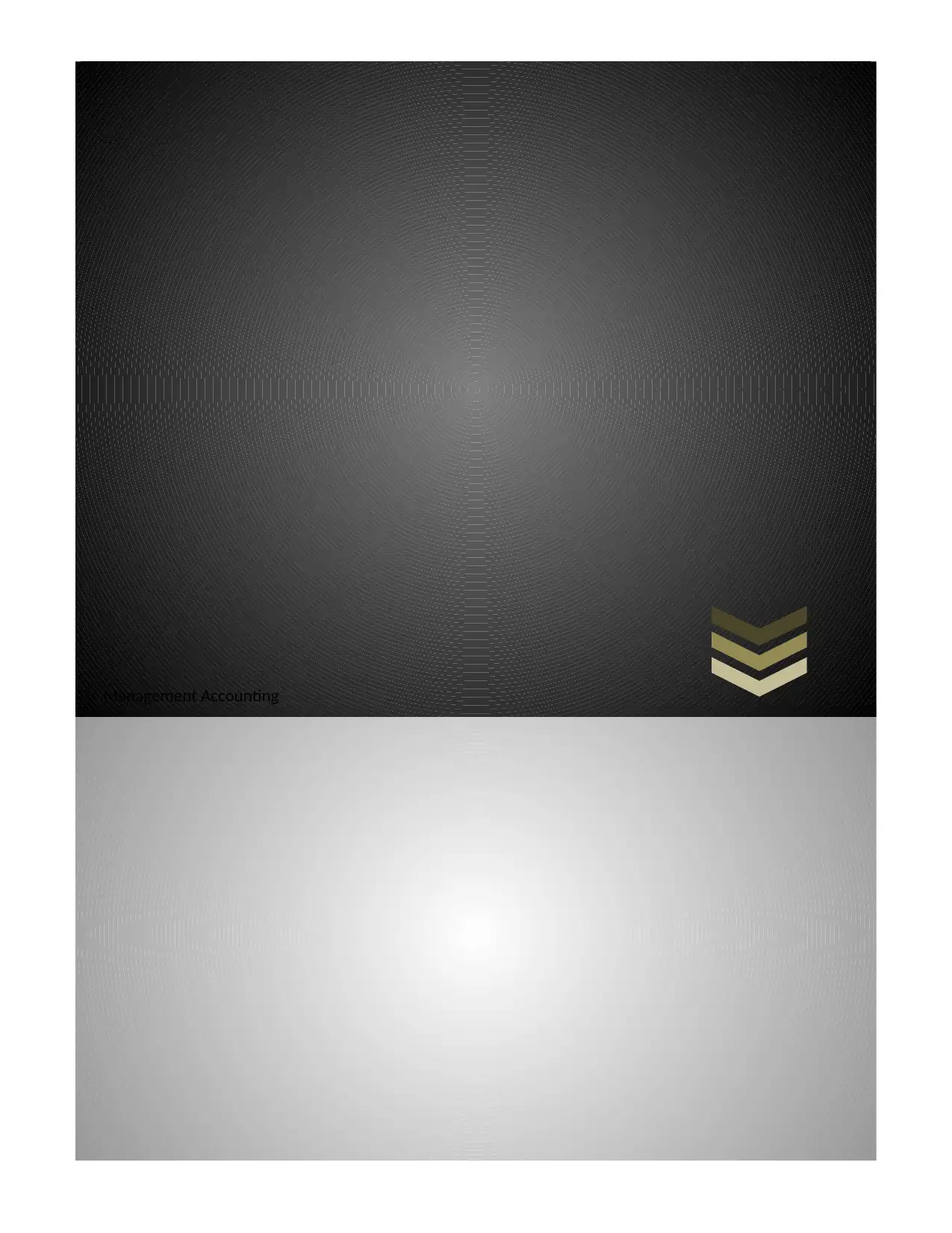
Management Accounting
Paraphrase This Document
Need a fresh take? Get an instant paraphrase of this document with our AI Paraphraser
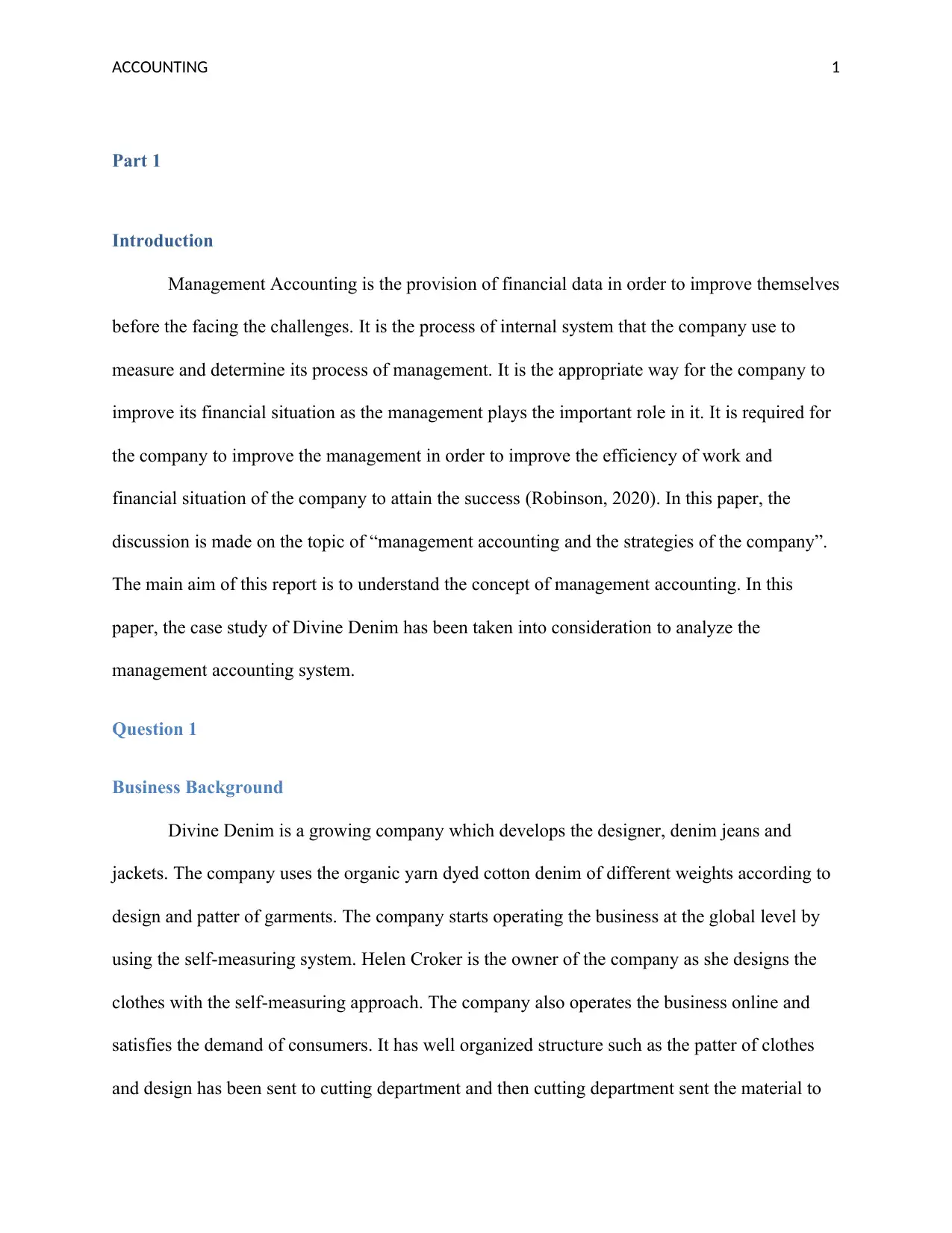
ACCOUNTING 1
Part 1
Introduction
Management Accounting is the provision of financial data in order to improve themselves
before the facing the challenges. It is the process of internal system that the company use to
measure and determine its process of management. It is the appropriate way for the company to
improve its financial situation as the management plays the important role in it. It is required for
the company to improve the management in order to improve the efficiency of work and
financial situation of the company to attain the success (Robinson, 2020). In this paper, the
discussion is made on the topic of “management accounting and the strategies of the company”.
The main aim of this report is to understand the concept of management accounting. In this
paper, the case study of Divine Denim has been taken into consideration to analyze the
management accounting system.
Question 1
Business Background
Divine Denim is a growing company which develops the designer, denim jeans and
jackets. The company uses the organic yarn dyed cotton denim of different weights according to
design and patter of garments. The company starts operating the business at the global level by
using the self-measuring system. Helen Croker is the owner of the company as she designs the
clothes with the self-measuring approach. The company also operates the business online and
satisfies the demand of consumers. It has well organized structure such as the patter of clothes
and design has been sent to cutting department and then cutting department sent the material to
Part 1
Introduction
Management Accounting is the provision of financial data in order to improve themselves
before the facing the challenges. It is the process of internal system that the company use to
measure and determine its process of management. It is the appropriate way for the company to
improve its financial situation as the management plays the important role in it. It is required for
the company to improve the management in order to improve the efficiency of work and
financial situation of the company to attain the success (Robinson, 2020). In this paper, the
discussion is made on the topic of “management accounting and the strategies of the company”.
The main aim of this report is to understand the concept of management accounting. In this
paper, the case study of Divine Denim has been taken into consideration to analyze the
management accounting system.
Question 1
Business Background
Divine Denim is a growing company which develops the designer, denim jeans and
jackets. The company uses the organic yarn dyed cotton denim of different weights according to
design and patter of garments. The company starts operating the business at the global level by
using the self-measuring system. Helen Croker is the owner of the company as she designs the
clothes with the self-measuring approach. The company also operates the business online and
satisfies the demand of consumers. It has well organized structure such as the patter of clothes
and design has been sent to cutting department and then cutting department sent the material to
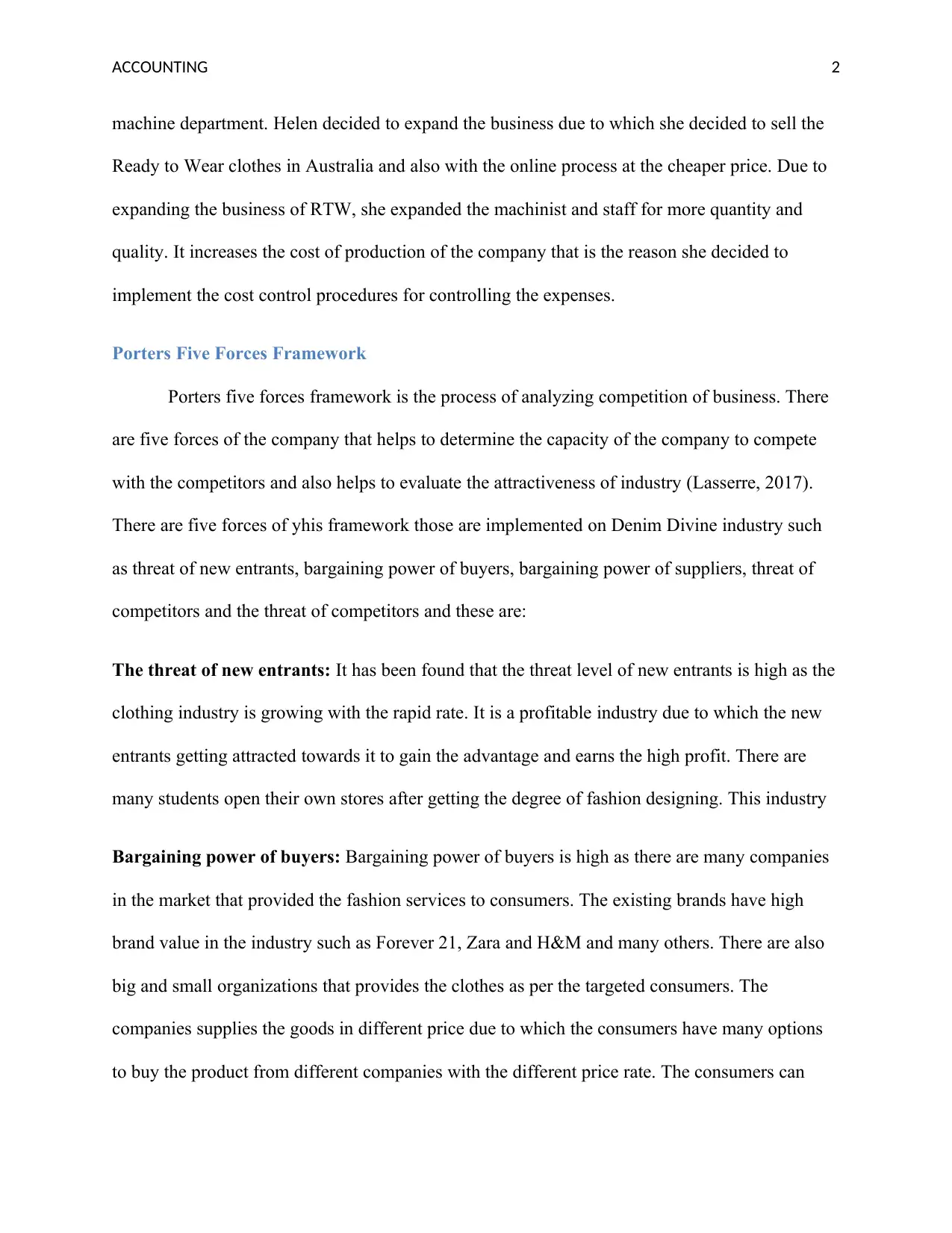
ACCOUNTING 2
machine department. Helen decided to expand the business due to which she decided to sell the
Ready to Wear clothes in Australia and also with the online process at the cheaper price. Due to
expanding the business of RTW, she expanded the machinist and staff for more quantity and
quality. It increases the cost of production of the company that is the reason she decided to
implement the cost control procedures for controlling the expenses.
Porters Five Forces Framework
Porters five forces framework is the process of analyzing competition of business. There
are five forces of the company that helps to determine the capacity of the company to compete
with the competitors and also helps to evaluate the attractiveness of industry (Lasserre, 2017).
There are five forces of yhis framework those are implemented on Denim Divine industry such
as threat of new entrants, bargaining power of buyers, bargaining power of suppliers, threat of
competitors and the threat of competitors and these are:
The threat of new entrants: It has been found that the threat level of new entrants is high as the
clothing industry is growing with the rapid rate. It is a profitable industry due to which the new
entrants getting attracted towards it to gain the advantage and earns the high profit. There are
many students open their own stores after getting the degree of fashion designing. This industry
Bargaining power of buyers: Bargaining power of buyers is high as there are many companies
in the market that provided the fashion services to consumers. The existing brands have high
brand value in the industry such as Forever 21, Zara and H&M and many others. There are also
big and small organizations that provides the clothes as per the targeted consumers. The
companies supplies the goods in different price due to which the consumers have many options
to buy the product from different companies with the different price rate. The consumers can
machine department. Helen decided to expand the business due to which she decided to sell the
Ready to Wear clothes in Australia and also with the online process at the cheaper price. Due to
expanding the business of RTW, she expanded the machinist and staff for more quantity and
quality. It increases the cost of production of the company that is the reason she decided to
implement the cost control procedures for controlling the expenses.
Porters Five Forces Framework
Porters five forces framework is the process of analyzing competition of business. There
are five forces of the company that helps to determine the capacity of the company to compete
with the competitors and also helps to evaluate the attractiveness of industry (Lasserre, 2017).
There are five forces of yhis framework those are implemented on Denim Divine industry such
as threat of new entrants, bargaining power of buyers, bargaining power of suppliers, threat of
competitors and the threat of competitors and these are:
The threat of new entrants: It has been found that the threat level of new entrants is high as the
clothing industry is growing with the rapid rate. It is a profitable industry due to which the new
entrants getting attracted towards it to gain the advantage and earns the high profit. There are
many students open their own stores after getting the degree of fashion designing. This industry
Bargaining power of buyers: Bargaining power of buyers is high as there are many companies
in the market that provided the fashion services to consumers. The existing brands have high
brand value in the industry such as Forever 21, Zara and H&M and many others. There are also
big and small organizations that provides the clothes as per the targeted consumers. The
companies supplies the goods in different price due to which the consumers have many options
to buy the product from different companies with the different price rate. The consumers can
⊘ This is a preview!⊘
Do you want full access?
Subscribe today to unlock all pages.

Trusted by 1+ million students worldwide
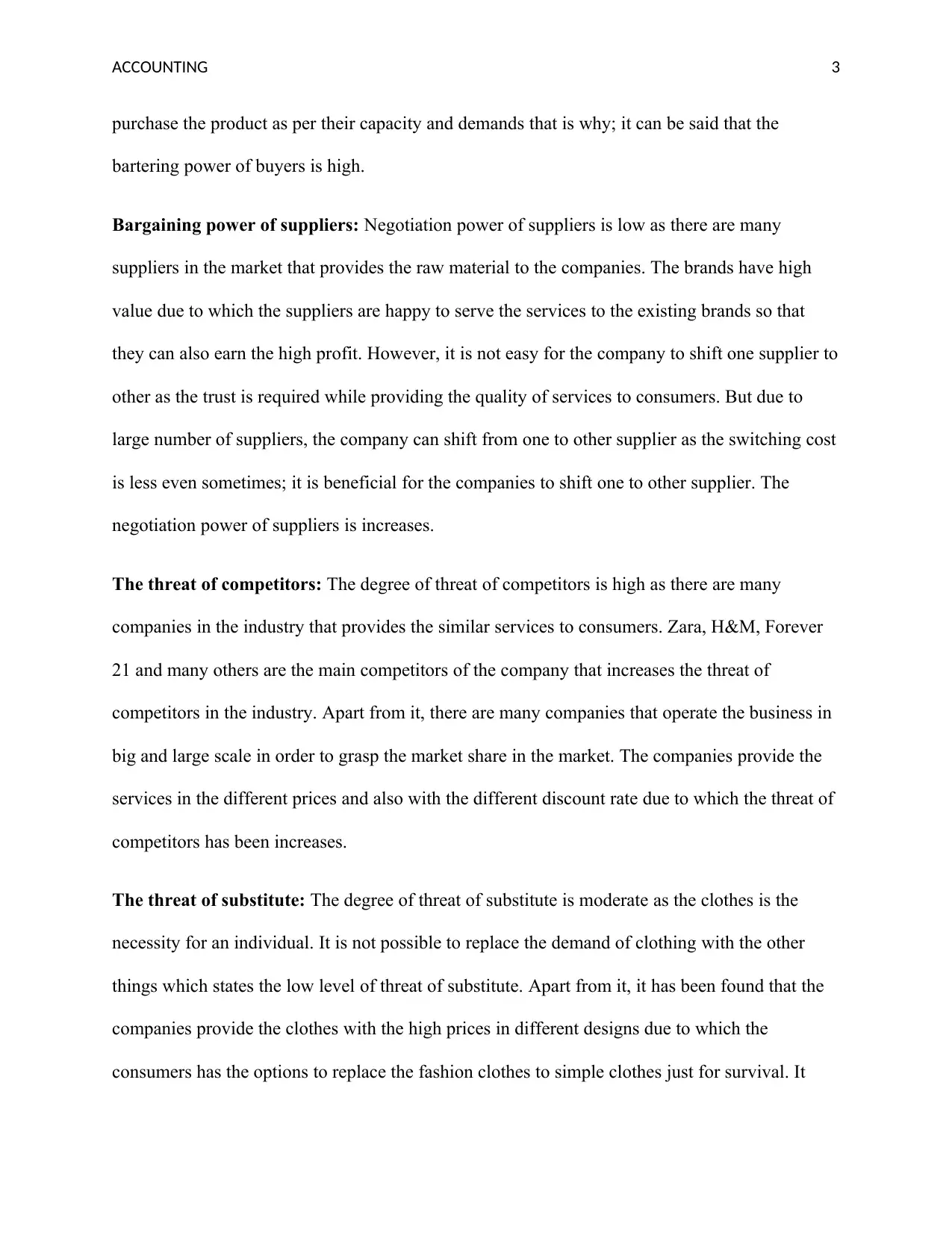
ACCOUNTING 3
purchase the product as per their capacity and demands that is why; it can be said that the
bartering power of buyers is high.
Bargaining power of suppliers: Negotiation power of suppliers is low as there are many
suppliers in the market that provides the raw material to the companies. The brands have high
value due to which the suppliers are happy to serve the services to the existing brands so that
they can also earn the high profit. However, it is not easy for the company to shift one supplier to
other as the trust is required while providing the quality of services to consumers. But due to
large number of suppliers, the company can shift from one to other supplier as the switching cost
is less even sometimes; it is beneficial for the companies to shift one to other supplier. The
negotiation power of suppliers is increases.
The threat of competitors: The degree of threat of competitors is high as there are many
companies in the industry that provides the similar services to consumers. Zara, H&M, Forever
21 and many others are the main competitors of the company that increases the threat of
competitors in the industry. Apart from it, there are many companies that operate the business in
big and large scale in order to grasp the market share in the market. The companies provide the
services in the different prices and also with the different discount rate due to which the threat of
competitors has been increases.
The threat of substitute: The degree of threat of substitute is moderate as the clothes is the
necessity for an individual. It is not possible to replace the demand of clothing with the other
things which states the low level of threat of substitute. Apart from it, it has been found that the
companies provide the clothes with the high prices in different designs due to which the
consumers has the options to replace the fashion clothes to simple clothes just for survival. It
purchase the product as per their capacity and demands that is why; it can be said that the
bartering power of buyers is high.
Bargaining power of suppliers: Negotiation power of suppliers is low as there are many
suppliers in the market that provides the raw material to the companies. The brands have high
value due to which the suppliers are happy to serve the services to the existing brands so that
they can also earn the high profit. However, it is not easy for the company to shift one supplier to
other as the trust is required while providing the quality of services to consumers. But due to
large number of suppliers, the company can shift from one to other supplier as the switching cost
is less even sometimes; it is beneficial for the companies to shift one to other supplier. The
negotiation power of suppliers is increases.
The threat of competitors: The degree of threat of competitors is high as there are many
companies in the industry that provides the similar services to consumers. Zara, H&M, Forever
21 and many others are the main competitors of the company that increases the threat of
competitors in the industry. Apart from it, there are many companies that operate the business in
big and large scale in order to grasp the market share in the market. The companies provide the
services in the different prices and also with the different discount rate due to which the threat of
competitors has been increases.
The threat of substitute: The degree of threat of substitute is moderate as the clothes is the
necessity for an individual. It is not possible to replace the demand of clothing with the other
things which states the low level of threat of substitute. Apart from it, it has been found that the
companies provide the clothes with the high prices in different designs due to which the
consumers has the options to replace the fashion clothes to simple clothes just for survival. It
Paraphrase This Document
Need a fresh take? Get an instant paraphrase of this document with our AI Paraphraser
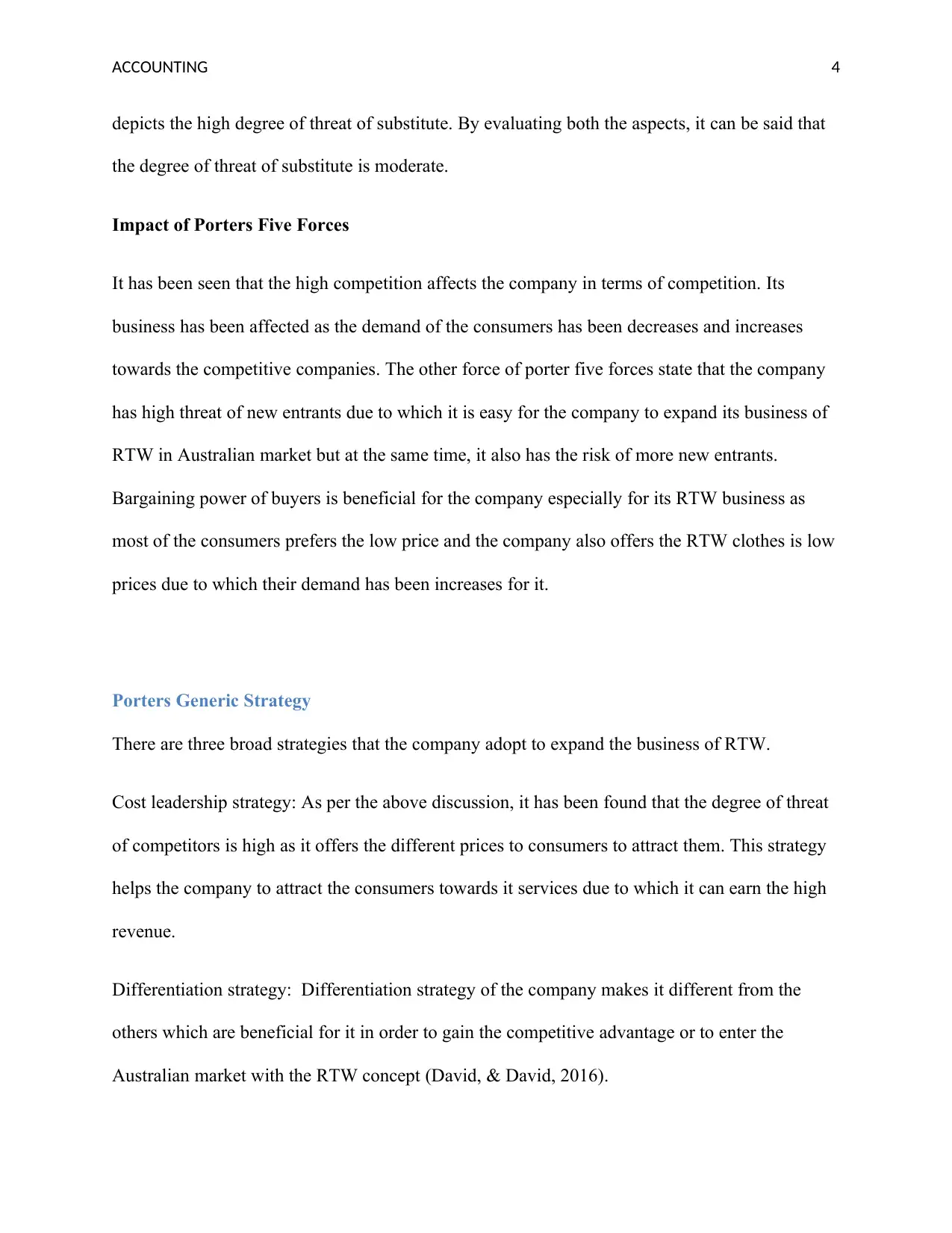
ACCOUNTING 4
depicts the high degree of threat of substitute. By evaluating both the aspects, it can be said that
the degree of threat of substitute is moderate.
Impact of Porters Five Forces
It has been seen that the high competition affects the company in terms of competition. Its
business has been affected as the demand of the consumers has been decreases and increases
towards the competitive companies. The other force of porter five forces state that the company
has high threat of new entrants due to which it is easy for the company to expand its business of
RTW in Australian market but at the same time, it also has the risk of more new entrants.
Bargaining power of buyers is beneficial for the company especially for its RTW business as
most of the consumers prefers the low price and the company also offers the RTW clothes is low
prices due to which their demand has been increases for it.
Porters Generic Strategy
There are three broad strategies that the company adopt to expand the business of RTW.
Cost leadership strategy: As per the above discussion, it has been found that the degree of threat
of competitors is high as it offers the different prices to consumers to attract them. This strategy
helps the company to attract the consumers towards it services due to which it can earn the high
revenue.
Differentiation strategy: Differentiation strategy of the company makes it different from the
others which are beneficial for it in order to gain the competitive advantage or to enter the
Australian market with the RTW concept (David, & David, 2016).
depicts the high degree of threat of substitute. By evaluating both the aspects, it can be said that
the degree of threat of substitute is moderate.
Impact of Porters Five Forces
It has been seen that the high competition affects the company in terms of competition. Its
business has been affected as the demand of the consumers has been decreases and increases
towards the competitive companies. The other force of porter five forces state that the company
has high threat of new entrants due to which it is easy for the company to expand its business of
RTW in Australian market but at the same time, it also has the risk of more new entrants.
Bargaining power of buyers is beneficial for the company especially for its RTW business as
most of the consumers prefers the low price and the company also offers the RTW clothes is low
prices due to which their demand has been increases for it.
Porters Generic Strategy
There are three broad strategies that the company adopt to expand the business of RTW.
Cost leadership strategy: As per the above discussion, it has been found that the degree of threat
of competitors is high as it offers the different prices to consumers to attract them. This strategy
helps the company to attract the consumers towards it services due to which it can earn the high
revenue.
Differentiation strategy: Differentiation strategy of the company makes it different from the
others which are beneficial for it in order to gain the competitive advantage or to enter the
Australian market with the RTW concept (David, & David, 2016).
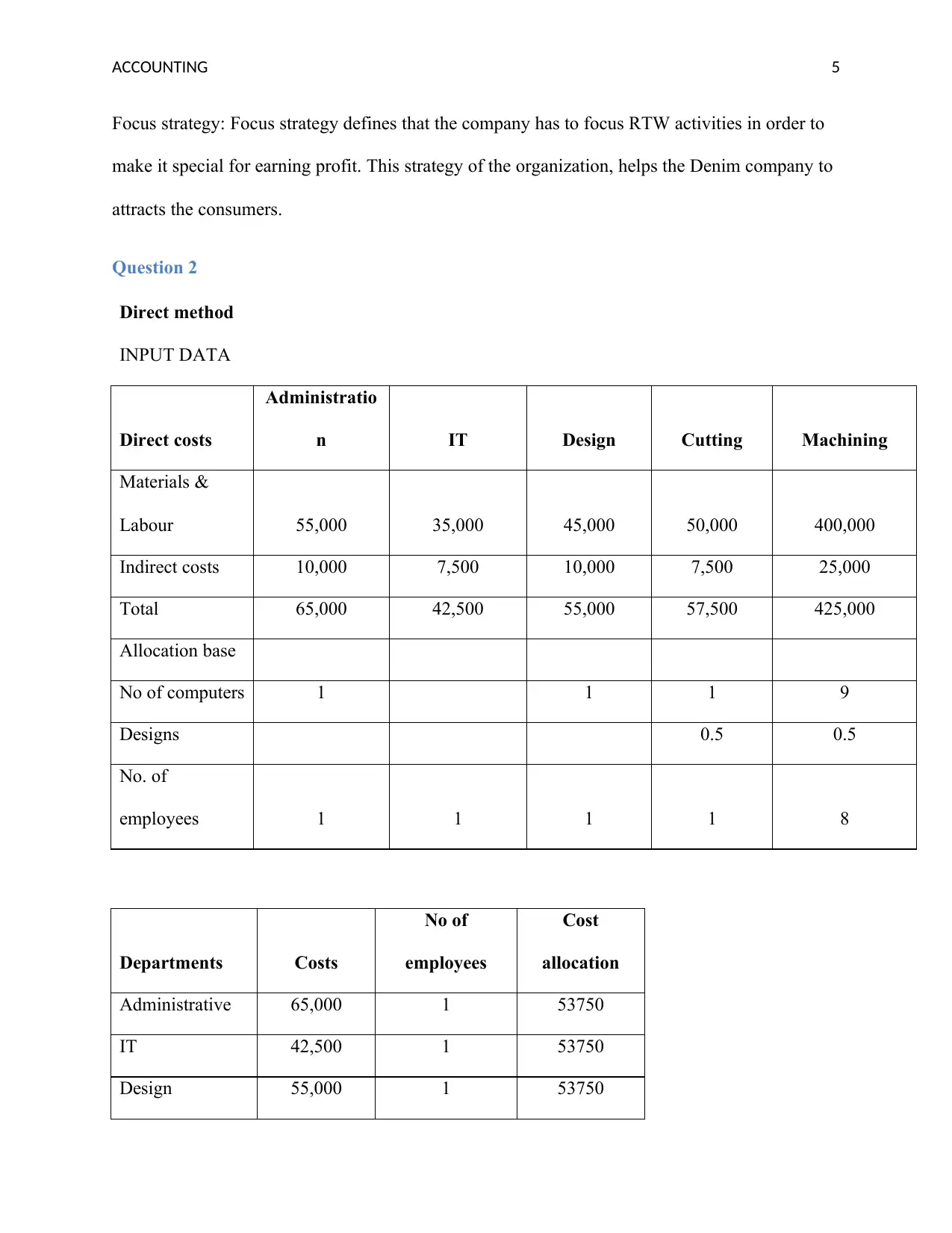
ACCOUNTING 5
Focus strategy: Focus strategy defines that the company has to focus RTW activities in order to
make it special for earning profit. This strategy of the organization, helps the Denim company to
attracts the consumers.
Question 2
Direct method
INPUT DATA
Direct costs
Administratio
n IT Design Cutting Machining
Materials &
Labour 55,000 35,000 45,000 50,000 400,000
Indirect costs 10,000 7,500 10,000 7,500 25,000
Total 65,000 42,500 55,000 57,500 425,000
Allocation base
No of computers 1 1 1 9
Designs 0.5 0.5
No. of
employees 1 1 1 1 8
Departments Costs
No of
employees
Cost
allocation
Administrative 65,000 1 53750
IT 42,500 1 53750
Design 55,000 1 53750
Focus strategy: Focus strategy defines that the company has to focus RTW activities in order to
make it special for earning profit. This strategy of the organization, helps the Denim company to
attracts the consumers.
Question 2
Direct method
INPUT DATA
Direct costs
Administratio
n IT Design Cutting Machining
Materials &
Labour 55,000 35,000 45,000 50,000 400,000
Indirect costs 10,000 7,500 10,000 7,500 25,000
Total 65,000 42,500 55,000 57,500 425,000
Allocation base
No of computers 1 1 1 9
Designs 0.5 0.5
No. of
employees 1 1 1 1 8
Departments Costs
No of
employees
Cost
allocation
Administrative 65,000 1 53750
IT 42,500 1 53750
Design 55,000 1 53750
⊘ This is a preview!⊘
Do you want full access?
Subscribe today to unlock all pages.

Trusted by 1+ million students worldwide
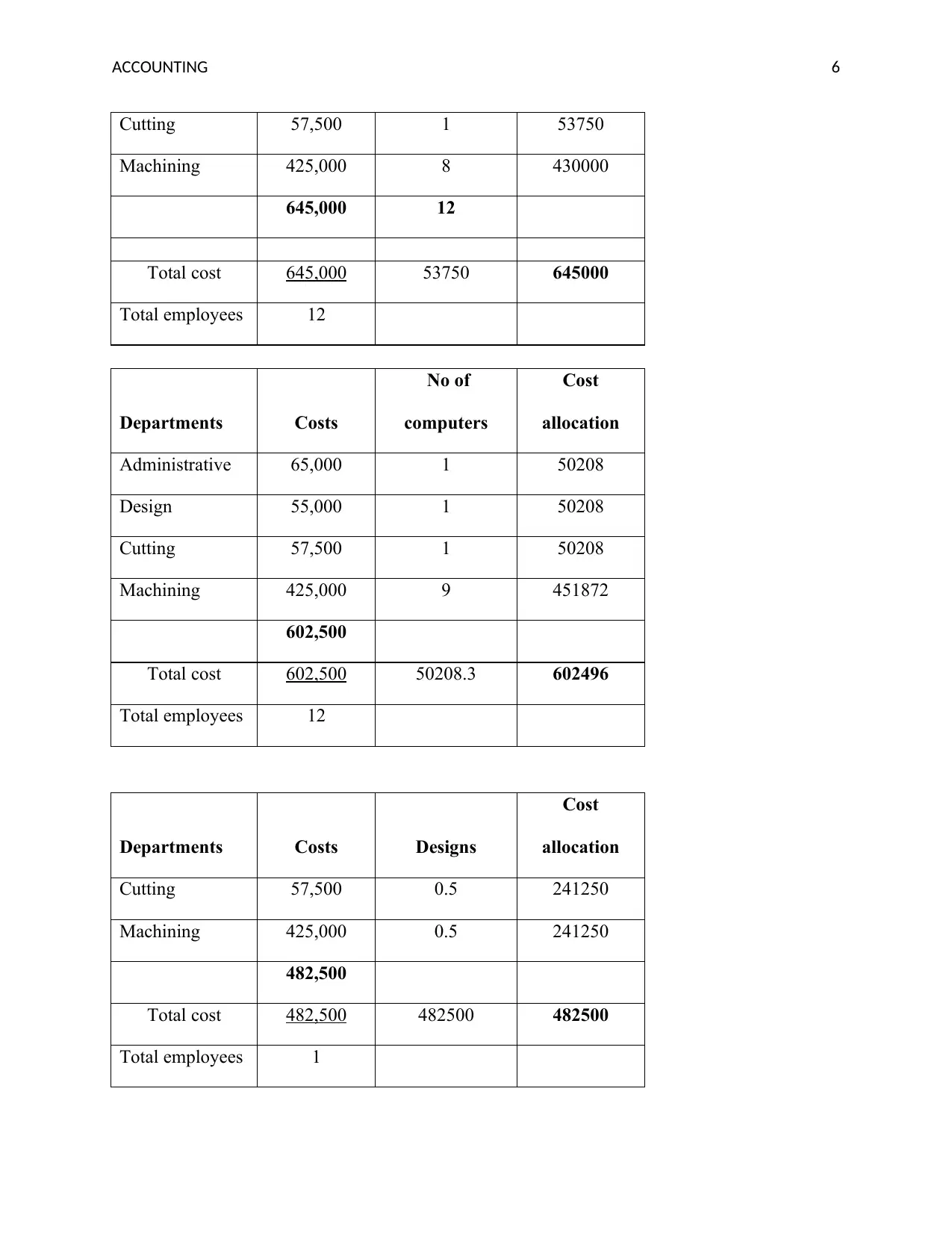
ACCOUNTING 6
Cutting 57,500 1 53750
Machining 425,000 8 430000
645,000 12
Total cost 645,000 53750 645000
Total employees 12
Departments Costs
No of
computers
Cost
allocation
Administrative 65,000 1 50208
Design 55,000 1 50208
Cutting 57,500 1 50208
Machining 425,000 9 451872
602,500
Total cost 602,500 50208.3 602496
Total employees 12
Departments Costs Designs
Cost
allocation
Cutting 57,500 0.5 241250
Machining 425,000 0.5 241250
482,500
Total cost 482,500 482500 482500
Total employees 1
Cutting 57,500 1 53750
Machining 425,000 8 430000
645,000 12
Total cost 645,000 53750 645000
Total employees 12
Departments Costs
No of
computers
Cost
allocation
Administrative 65,000 1 50208
Design 55,000 1 50208
Cutting 57,500 1 50208
Machining 425,000 9 451872
602,500
Total cost 602,500 50208.3 602496
Total employees 12
Departments Costs Designs
Cost
allocation
Cutting 57,500 0.5 241250
Machining 425,000 0.5 241250
482,500
Total cost 482,500 482500 482500
Total employees 1
Paraphrase This Document
Need a fresh take? Get an instant paraphrase of this document with our AI Paraphraser
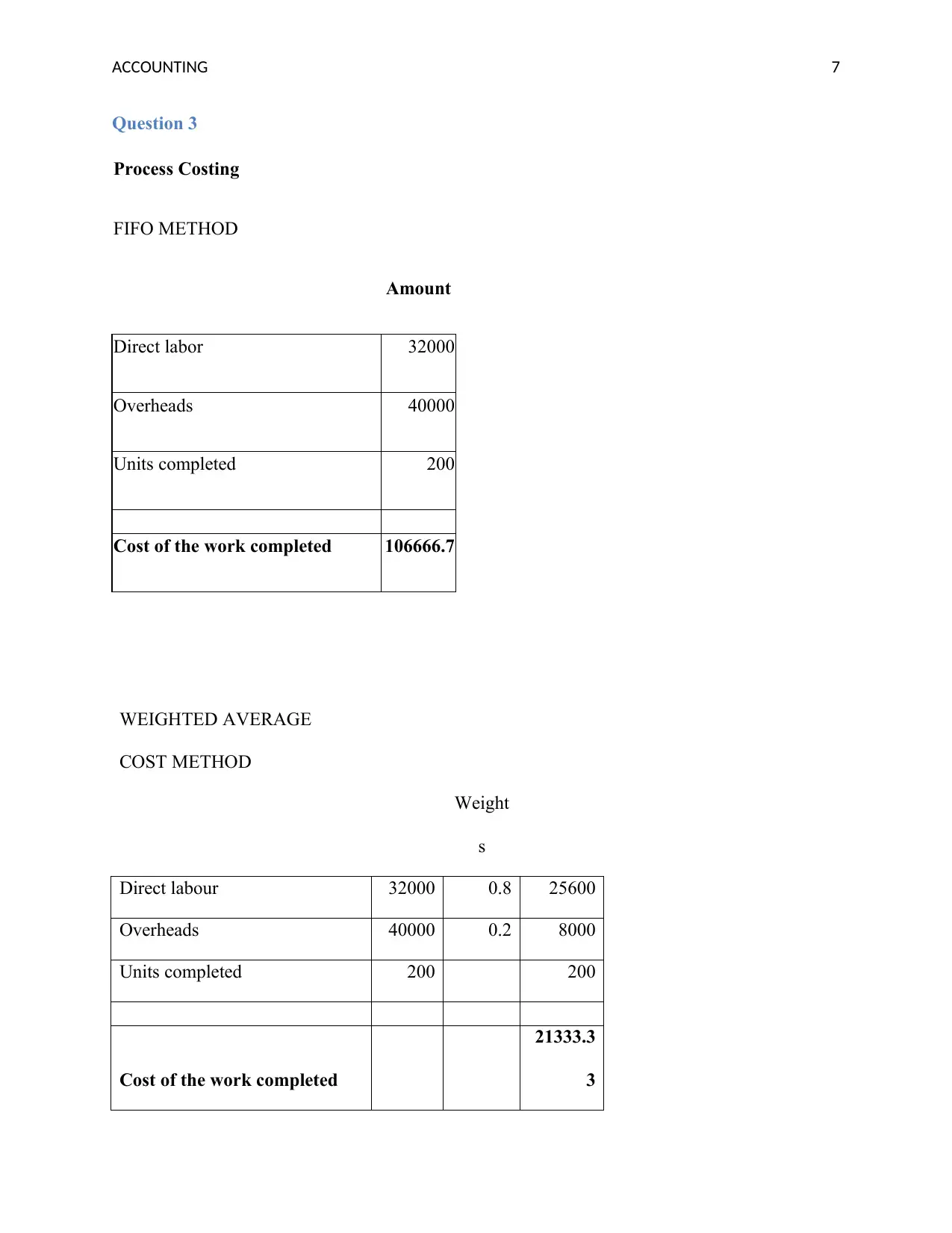
ACCOUNTING 7
Question 3
Process Costing
FIFO METHOD
Amount
Direct labor 32000
Overheads 40000
Units completed 200
Cost of the work completed 106666.7
WEIGHTED AVERAGE
COST METHOD
Weight
s
Direct labour 32000 0.8 25600
Overheads 40000 0.2 8000
Units completed 200 200
Cost of the work completed
21333.3
3
Question 3
Process Costing
FIFO METHOD
Amount
Direct labor 32000
Overheads 40000
Units completed 200
Cost of the work completed 106666.7
WEIGHTED AVERAGE
COST METHOD
Weight
s
Direct labour 32000 0.8 25600
Overheads 40000 0.2 8000
Units completed 200 200
Cost of the work completed
21333.3
3
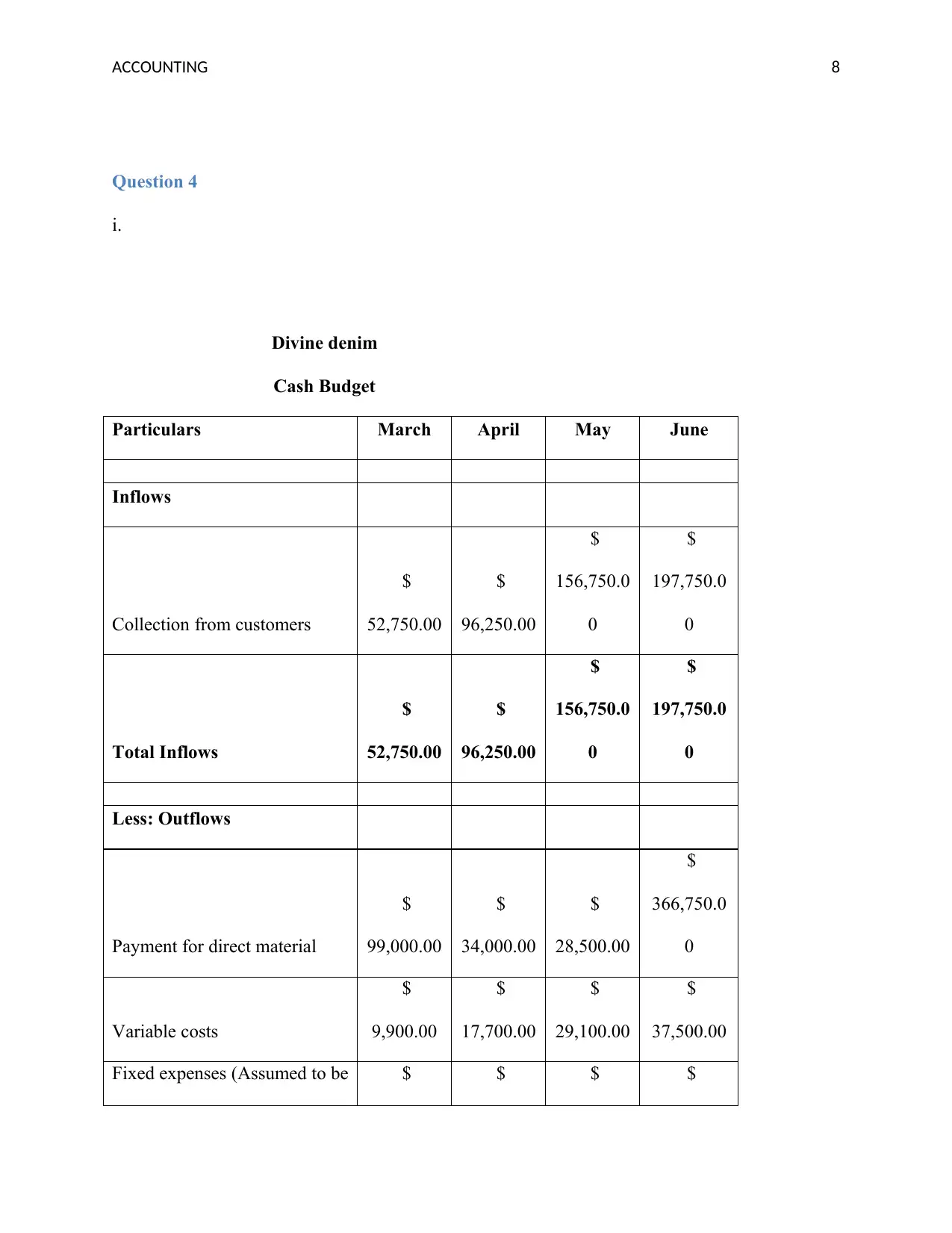
ACCOUNTING 8
Question 4
i.
Divine denim
Cash Budget
Particulars March April May June
Inflows
Collection from customers
$
52,750.00
$
96,250.00
$
156,750.0
0
$
197,750.0
0
Total Inflows
$
52,750.00
$
96,250.00
$
156,750.0
0
$
197,750.0
0
Less: Outflows
Payment for direct material
$
99,000.00
$
34,000.00
$
28,500.00
$
366,750.0
0
Variable costs
$
9,900.00
$
17,700.00
$
29,100.00
$
37,500.00
Fixed expenses (Assumed to be $ $ $ $
Question 4
i.
Divine denim
Cash Budget
Particulars March April May June
Inflows
Collection from customers
$
52,750.00
$
96,250.00
$
156,750.0
0
$
197,750.0
0
Total Inflows
$
52,750.00
$
96,250.00
$
156,750.0
0
$
197,750.0
0
Less: Outflows
Payment for direct material
$
99,000.00
$
34,000.00
$
28,500.00
$
366,750.0
0
Variable costs
$
9,900.00
$
17,700.00
$
29,100.00
$
37,500.00
Fixed expenses (Assumed to be $ $ $ $
⊘ This is a preview!⊘
Do you want full access?
Subscribe today to unlock all pages.

Trusted by 1+ million students worldwide
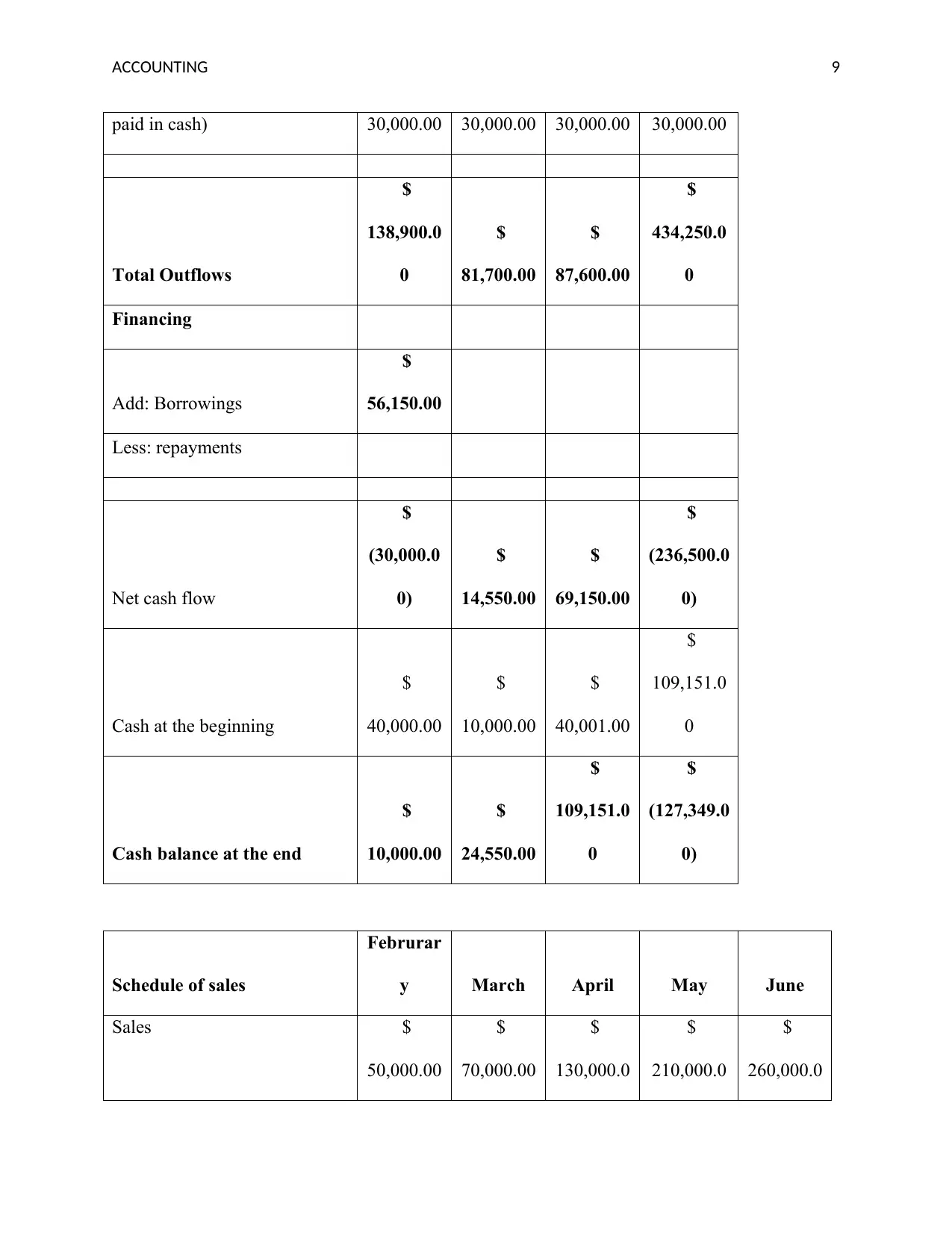
ACCOUNTING 9
paid in cash) 30,000.00 30,000.00 30,000.00 30,000.00
Total Outflows
$
138,900.0
0
$
81,700.00
$
87,600.00
$
434,250.0
0
Financing
Add: Borrowings
$
56,150.00
Less: repayments
Net cash flow
$
(30,000.0
0)
$
14,550.00
$
69,150.00
$
(236,500.0
0)
Cash at the beginning
$
40,000.00
$
10,000.00
$
40,001.00
$
109,151.0
0
Cash balance at the end
$
10,000.00
$
24,550.00
$
109,151.0
0
$
(127,349.0
0)
Schedule of sales
Februrar
y March April May June
Sales $
50,000.00
$
70,000.00
$
130,000.0
$
210,000.0
$
260,000.0
paid in cash) 30,000.00 30,000.00 30,000.00 30,000.00
Total Outflows
$
138,900.0
0
$
81,700.00
$
87,600.00
$
434,250.0
0
Financing
Add: Borrowings
$
56,150.00
Less: repayments
Net cash flow
$
(30,000.0
0)
$
14,550.00
$
69,150.00
$
(236,500.0
0)
Cash at the beginning
$
40,000.00
$
10,000.00
$
40,001.00
$
109,151.0
0
Cash balance at the end
$
10,000.00
$
24,550.00
$
109,151.0
0
$
(127,349.0
0)
Schedule of sales
Februrar
y March April May June
Sales $
50,000.00
$
70,000.00
$
130,000.0
$
210,000.0
$
260,000.0
Paraphrase This Document
Need a fresh take? Get an instant paraphrase of this document with our AI Paraphraser
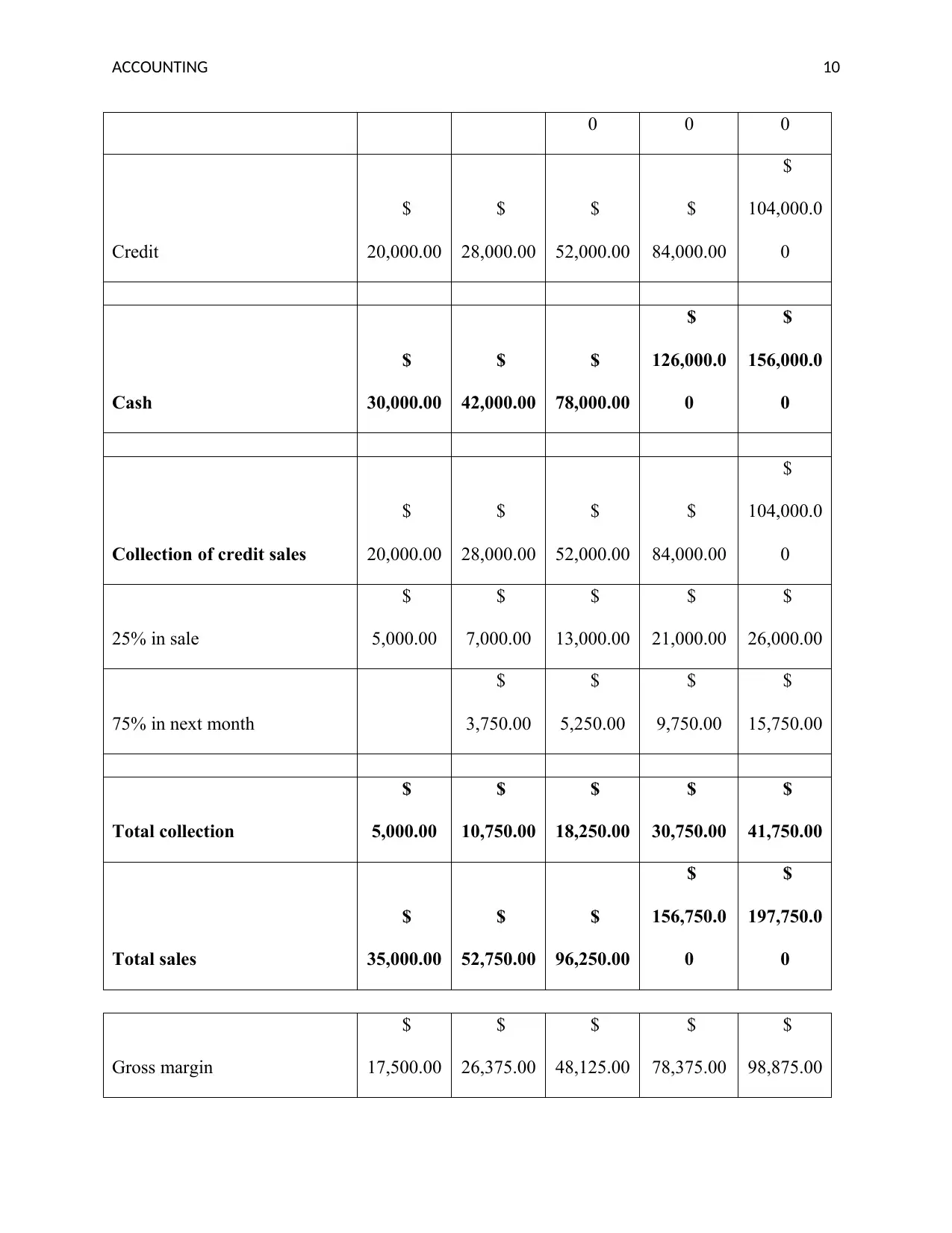
ACCOUNTING 10
0 0 0
Credit
$
20,000.00
$
28,000.00
$
52,000.00
$
84,000.00
$
104,000.0
0
Cash
$
30,000.00
$
42,000.00
$
78,000.00
$
126,000.0
0
$
156,000.0
0
Collection of credit sales
$
20,000.00
$
28,000.00
$
52,000.00
$
84,000.00
$
104,000.0
0
25% in sale
$
5,000.00
$
7,000.00
$
13,000.00
$
21,000.00
$
26,000.00
75% in next month
$
3,750.00
$
5,250.00
$
9,750.00
$
15,750.00
Total collection
$
5,000.00
$
10,750.00
$
18,250.00
$
30,750.00
$
41,750.00
Total sales
$
35,000.00
$
52,750.00
$
96,250.00
$
156,750.0
0
$
197,750.0
0
Gross margin
$
17,500.00
$
26,375.00
$
48,125.00
$
78,375.00
$
98,875.00
0 0 0
Credit
$
20,000.00
$
28,000.00
$
52,000.00
$
84,000.00
$
104,000.0
0
Cash
$
30,000.00
$
42,000.00
$
78,000.00
$
126,000.0
0
$
156,000.0
0
Collection of credit sales
$
20,000.00
$
28,000.00
$
52,000.00
$
84,000.00
$
104,000.0
0
25% in sale
$
5,000.00
$
7,000.00
$
13,000.00
$
21,000.00
$
26,000.00
75% in next month
$
3,750.00
$
5,250.00
$
9,750.00
$
15,750.00
Total collection
$
5,000.00
$
10,750.00
$
18,250.00
$
30,750.00
$
41,750.00
Total sales
$
35,000.00
$
52,750.00
$
96,250.00
$
156,750.0
0
$
197,750.0
0
Gross margin
$
17,500.00
$
26,375.00
$
48,125.00
$
78,375.00
$
98,875.00
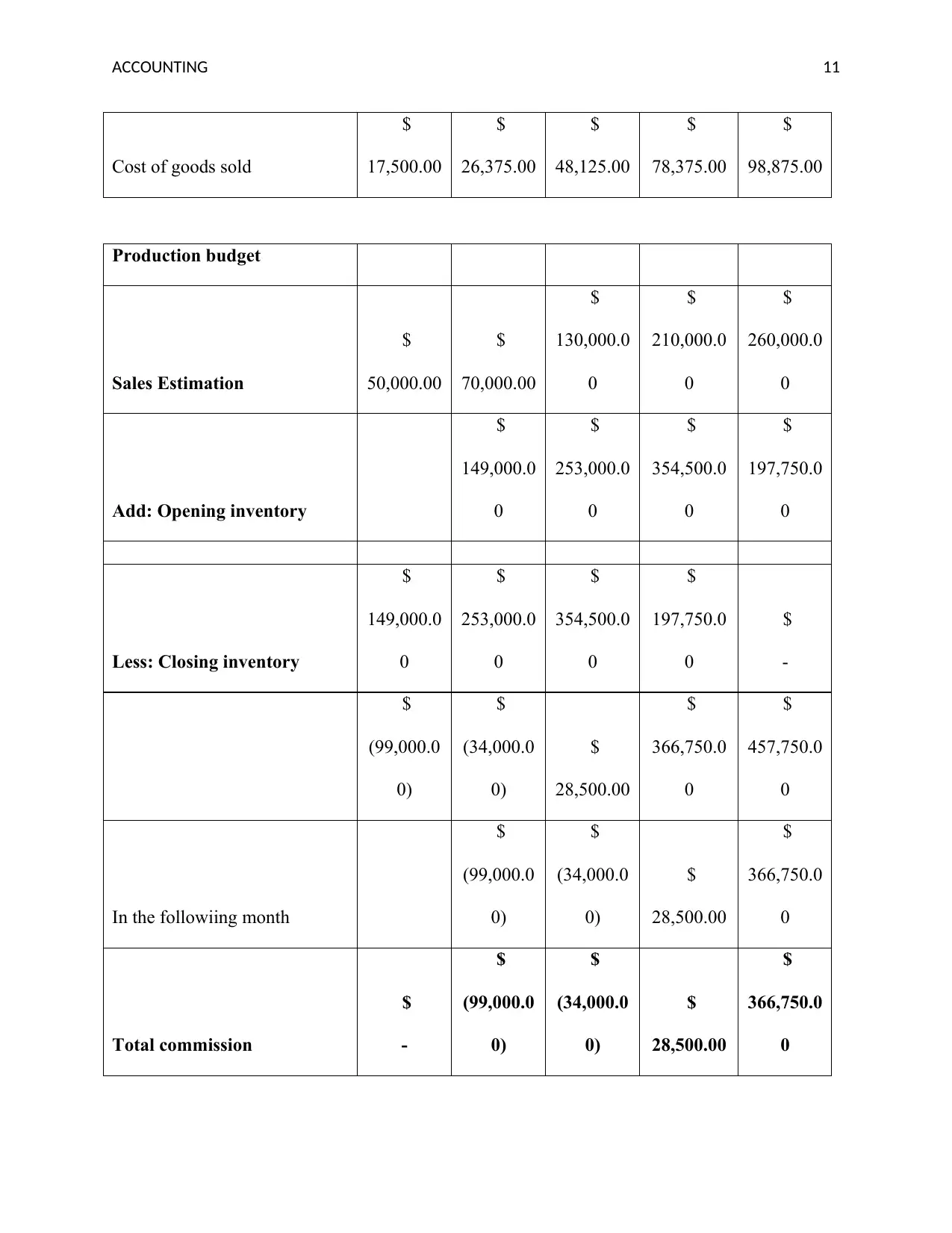
ACCOUNTING 11
Cost of goods sold
$
17,500.00
$
26,375.00
$
48,125.00
$
78,375.00
$
98,875.00
Production budget
Sales Estimation
$
50,000.00
$
70,000.00
$
130,000.0
0
$
210,000.0
0
$
260,000.0
0
Add: Opening inventory
$
149,000.0
0
$
253,000.0
0
$
354,500.0
0
$
197,750.0
0
Less: Closing inventory
$
149,000.0
0
$
253,000.0
0
$
354,500.0
0
$
197,750.0
0
$
-
$
(99,000.0
0)
$
(34,000.0
0)
$
28,500.00
$
366,750.0
0
$
457,750.0
0
In the followiing month
$
(99,000.0
0)
$
(34,000.0
0)
$
28,500.00
$
366,750.0
0
Total commission
$
-
$
(99,000.0
0)
$
(34,000.0
0)
$
28,500.00
$
366,750.0
0
Cost of goods sold
$
17,500.00
$
26,375.00
$
48,125.00
$
78,375.00
$
98,875.00
Production budget
Sales Estimation
$
50,000.00
$
70,000.00
$
130,000.0
0
$
210,000.0
0
$
260,000.0
0
Add: Opening inventory
$
149,000.0
0
$
253,000.0
0
$
354,500.0
0
$
197,750.0
0
Less: Closing inventory
$
149,000.0
0
$
253,000.0
0
$
354,500.0
0
$
197,750.0
0
$
-
$
(99,000.0
0)
$
(34,000.0
0)
$
28,500.00
$
366,750.0
0
$
457,750.0
0
In the followiing month
$
(99,000.0
0)
$
(34,000.0
0)
$
28,500.00
$
366,750.0
0
Total commission
$
-
$
(99,000.0
0)
$
(34,000.0
0)
$
28,500.00
$
366,750.0
0
⊘ This is a preview!⊘
Do you want full access?
Subscribe today to unlock all pages.

Trusted by 1+ million students worldwide
1 out of 18
Related Documents
Your All-in-One AI-Powered Toolkit for Academic Success.
+13062052269
info@desklib.com
Available 24*7 on WhatsApp / Email
![[object Object]](/_next/static/media/star-bottom.7253800d.svg)
Unlock your academic potential
Copyright © 2020–2025 A2Z Services. All Rights Reserved. Developed and managed by ZUCOL.





